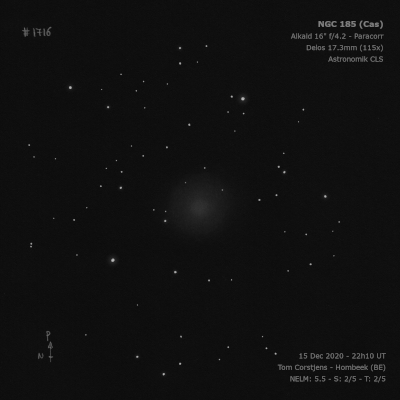
William Herschel discovered NGC 185 = H II-707 = h35 on 30 Nov 1787 (sweep 786) and recorded "pB, vL, irr R, vgmbM, resolvable, 5 or 6' diameter." The first observation with LdR's 72" on 28 Mar 1848 reads "Resolved by a power of 800, although the night was rather hazy." This is a good example of how preconceptions that nearly all nebulae were resolvable influenced the results. The NGC position is accurate.
James Keeler first photographed the galaxy using the Crossley reflector at Lick before 1900. It was described (1918 Curtis publication) as "rather irregular slightly oval, 3' long; there are two curious rifts near the nucleus; it appears to be an irregular spiral. The nebular matter is faint and diffuse. A star of mag 14 is north of the very faint nucleus."
In 1944 William Baade announced that NGC 185, along with NGC 147, were members of the Local Group (1944ApJ...100..147B) when they were resolved into stars on plates take with the 100-inch at Mt Wilson. In an unusual situation, Baade requested that an actual photographic print of NGC 185 was bound in his ApJ paper to demonstrate resolution, as detail was lost with an ordinary halftone illustration.
200/250mm - 8" (10/4/80): fairly faint, fairly large, diffuse, NGC 147 58' WNW.
400/500mm - 17.5" (10/13/90): bright, very large, slightly elongated ~E-W, broad concentration but no nucleus. Three mag 14 stars are at the W, NW and SW ends. Higher surface brightness than NGC 147. The brightest globular is located 8' N of center and is a marginal object at high power (see description). This is a satellite system of M31 and a Local Group member at a distance of 2.15 million light years.
600/800mm - 24" (9/14/12): Hodge V is the brightest globular cluster in NGC 185, first identified by Paul Hodge in his 1974 paper "Photometry of the Globular Clusters of NGC 185" (PASP, 86, 289). At 325x and 450x it appeared as an extremely faint star (V = 16.7), forming the southern vertex of a small equilateral triangle with a mag 14.5 star 20" N and a mag 15 star 20" NW. This extragalactic globular was repeatedly glimpsed for brief moments and a couple of times it could be held for a few seconds. Situated 3.8' NE of the center of NGC 185 and outside the visible halo of the galaxy.
Notes by Steve Gottlieb